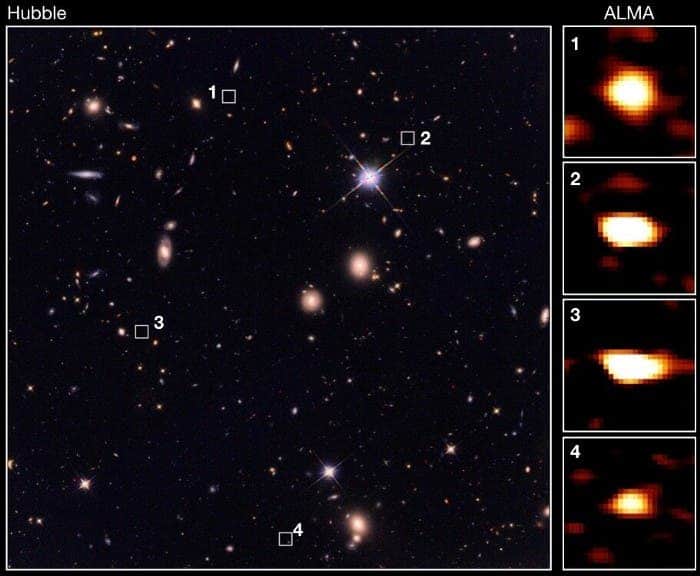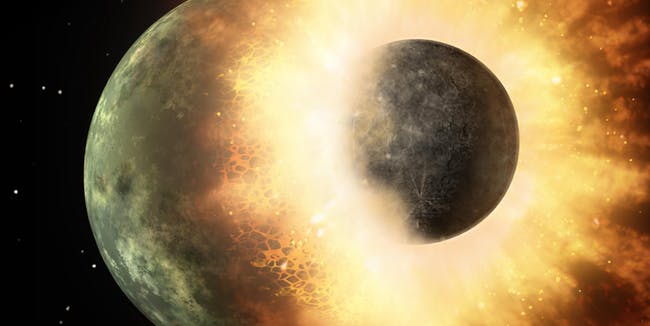Scientists using the Atacama Large Millimeter/submillimeter Array (ALMA) have uncovered some insight into water’s path from gas clouds during star formation to a planet’s surface. The National Radio Astronomy Observatory (NRAO) team’s discovery suggests that Earth’s water could be even older than the Sun. The astronomers made the discovery after studying the water composition in V883 Orionis, a planet-forming disc located about 1300 light-years from Earth.
“We can now trace the origins of water in our Solar System to before the formation of the Sun,” said John J. Tobin, an astronomer at the NRAO and lead author of the study published in Nature.
Star formation begins with a collapsing cloud of gas and dust. Around the star, material from the cloud also forms a disc. Over a few million years, the matter in the disc clumps together to form comets, asteroids and eventually planets. The NRAO researchers used the European Space Agency’s ALMA to measure the chemical signatures of the water and its path from the star-forming cloud to planets.
Water is composed of one oxygen atom and two hydrogen atoms. Tobin’s team studied a variant of water that replaces one hydrogen atom with deuterium, a heavier isotope of hydrogen. Since simple and heavy water form under distinct environmental circumstances, the ratio of the two can be used to reconstruct the water’s formation time and location. The discovery that this ratio exists in some comets in the Solar System is significant because it suggests that comets may have delivered water to Earth.
It has been previously observed that water travels from clouds to young stars and then from comets to planets, but the connection between young stars and comets has been lacking until now.
“V883 Orionis is the missing link in this case,” Tobin said. “The composition of the water in the disc is very similar to that of comets in our own Solar System. This is confirmation of the idea that the water in planetary systems formed billions of years ago, before the Sun, in interstellar space, and has been inherited by both comets and Earth, relatively unchanged.”
Observing the water turned out to be a bit tricky, though.
“Most of the water in planet-forming discs is frozen out as ice, so it’s usually hidden from our view,” says co-author Margot Leemker, a Ph.D. student at Leiden Observatory in the Netherlands.
The radiation given off by molecules as they spin and vibrate can be used to detect gaseous water, but this becomes more challenging when the water is frozen because the molecules’ motion is more restricted. Near the star, where it is warmer, in the center of the discs, there is gaseous water. However, the dust disc itself obscures these nearby regions, and they are also too small to be imaged with current telescopes.
Fortunately, the V883 Orionis disc was shown in a 2016 study to be unusually hot. A dramatic outburst of energy from the star heats the disc to a temperature where water is no longer in the form of ice, but gas, enabling astronomers to detect it.
The team was able to determine the water’s composition and map its distribution within the disc. They determined that this disc contains at least 1200 times as much water as all of Earth’s oceans do from their observations.
Tobin and his group plan to use the upcoming Extremely Large Telescope and its first-generation instrument Mid-infrared ELT Imager and Spectrograph (METIS) for future study. When this mid-infrared instrument deploys, it will be able to resolve the gas-phase water in these discs, further cementing the path water takes from star-forming clouds to solar systems. This will allow astronomers to see the ice and gas in planet-forming discs in greater detail.
”This will give us a much more complete view of the ice and gas in planet-forming discs,” Leemker said.







